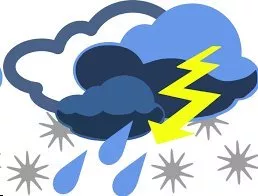View Other Topics.
 Jul 19, 2017
Jul 19, 2017
Rain - and other forms of precipitation - occur when warm moist air cools and condensation occurs.
Since warm air can hold more water than cool air, when the warmer air is cooled the moisture condenses to liquid - and it rains.
Mountainous areas close to prevailing westerly winds are most likely to experience this type of rainfall. The geography of the UK means that this type of rainfall is most common in the north and west of the UK where warm moist air from the Atlantic cools as it is forced upwards over high altitudes.
When you heat the air from below like this, much like in a boiling kettle, you tend to get "bubbles" of rising air, known as updraughts. These are much smaller than the large-scale lifting of air that occurs at fronts and over mountain ranges. This tends to give us smaller areas of rain, with clear spells in between, commonly referred to in the UK as "sunshine and showers".
This type of rainfall is most common in the south and east of the UK, where it is typically warmer. This area is also prone to very heavy showers and thunderstorms, this is because the warmer air can hold more water.
Sometimes, you can get all three types of rain at once, and this can lead to severe flooding.
Image: Rainstorm - clipart-work.net
Tags:
#rain,#july,#starzpsychics.com,#starz#advisors
Why Does It Rain?.

It's July and sudden rain showers and thunderstorms can pop up seemingly out of nowhere. Here from metoffice.gov.uk we learn just what makes it rain.
There are three different ways of turning moist air into cloud, so that it rains or snows.Rain - and other forms of precipitation - occur when warm moist air cools and condensation occurs.
Since warm air can hold more water than cool air, when the warmer air is cooled the moisture condenses to liquid - and it rains.
Frontal rain
Frontal rain occurs when two air masses meet. When a warm air mass meets a cold air mass, they don't mix as they have different densities (a bit like oil and water). Instead, the warm less dense air is pushed up over the cold dense air creating the 'front'. As a result, much like when air is forced up over mountains, the warm less dense air cools, and the water vapour condenses into water and falls as raindrops. This type of rain can happen anywhere in the UK.Orographic rain
Orographic rain is rainfall produced as a result of clouds formed from the topography - or shape - of the land. Where there is high ground moist air is forced upwards producing cloud and potentially, precipitation.Mountainous areas close to prevailing westerly winds are most likely to experience this type of rainfall. The geography of the UK means that this type of rainfall is most common in the north and west of the UK where warm moist air from the Atlantic cools as it is forced upwards over high altitudes.
Convective rain
Convective rain is produced by convective cloud. Convective cloud is formed in vertical motions that result from instability of the atmosphere. One way that the atmosphere can become unstable is by heating from the sun. The ground warms up, causing moisture in the ground to evaporate and rise, and the hot ground also heats the air above it. As the water vapour rises, it cools and condenses into clouds and eventually rain.When you heat the air from below like this, much like in a boiling kettle, you tend to get "bubbles" of rising air, known as updraughts. These are much smaller than the large-scale lifting of air that occurs at fronts and over mountain ranges. This tends to give us smaller areas of rain, with clear spells in between, commonly referred to in the UK as "sunshine and showers".
This type of rainfall is most common in the south and east of the UK, where it is typically warmer. This area is also prone to very heavy showers and thunderstorms, this is because the warmer air can hold more water.
Sometimes, you can get all three types of rain at once, and this can lead to severe flooding.
Image: Rainstorm - clipart-work.net
Share this article with friends!
Tags:
#rain,#july,#starzpsychics.com,#starz#advisors






